Analysis of Supply Chain Management and Quality at Procter & Gamble
VerifiedAdded on 2022/09/05
|12
|1882
|16
Report
AI Summary
This report provides a comprehensive analysis of Procter & Gamble's (P&G) supply chain management, emphasizing the importance of quality assurance and its impact on the company's performance. The report begins with a rationale for studying P&G's supply chain, highlighting the role of quality management in maintaining consumer trust and brand loyalty within a competitive market. It then delves into a situation analysis, outlining P&G's current quality management practices, including the establishment of quality control laboratories and adherence to pre-set quality standards. The report identifies problems faced by P&G, such as issues with product quantity and quality, and proposes solutions like implementing checkweigher machines and utilizing in-vitro testing methods. Furthermore, the report explores various approaches P&G can implement to improve its efficiency, such as inventory management through the Just-in-Time technique, strategic plant locations near suppliers, enhanced sustainability efforts, and continuous employee training and development. The report concludes by summarizing the importance of adapting supply chain techniques to available resources and the benefits of quality management in achieving a competitive advantage.
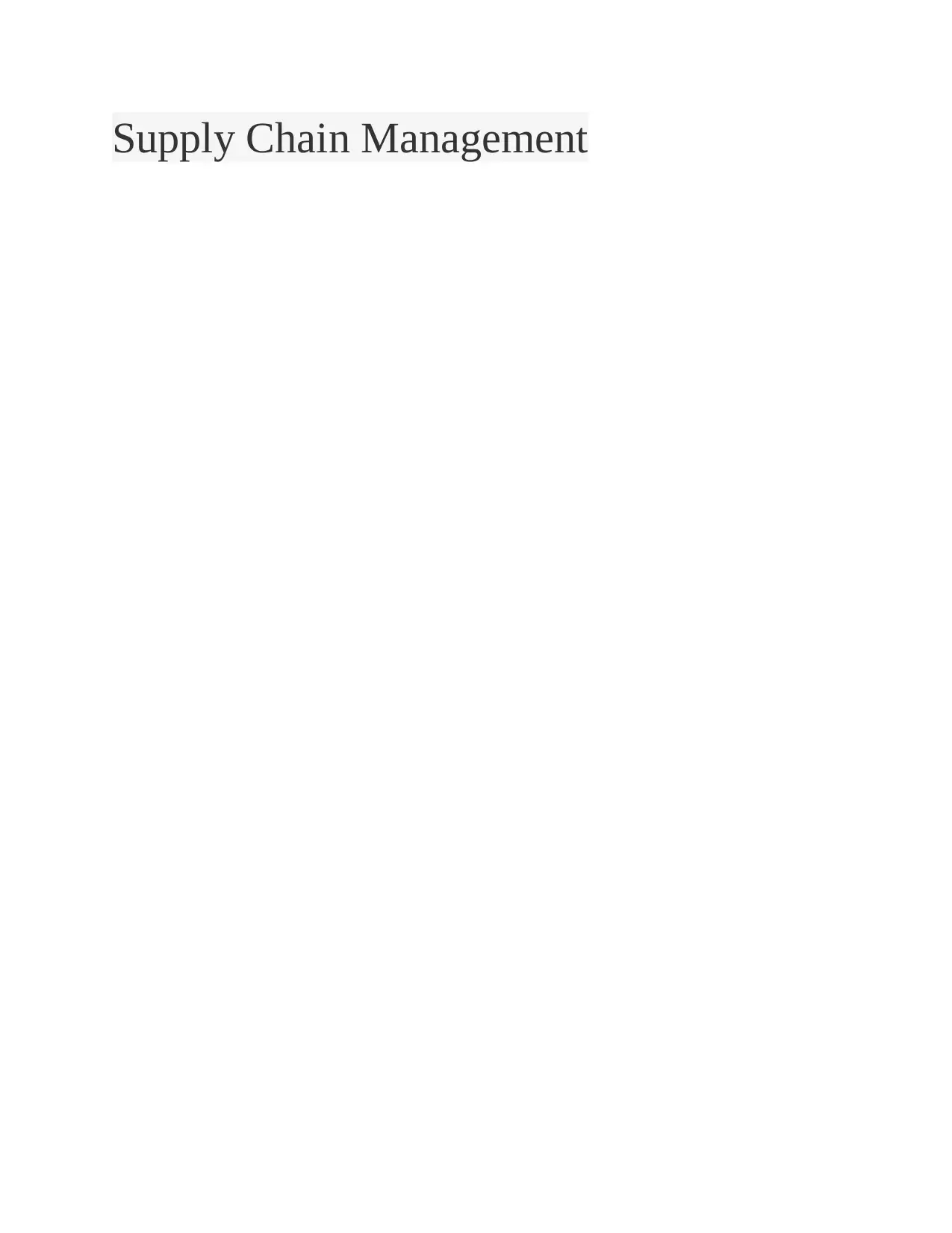
Supply Chain Management
Paraphrase This Document
Need a fresh take? Get an instant paraphrase of this document with our AI Paraphraser
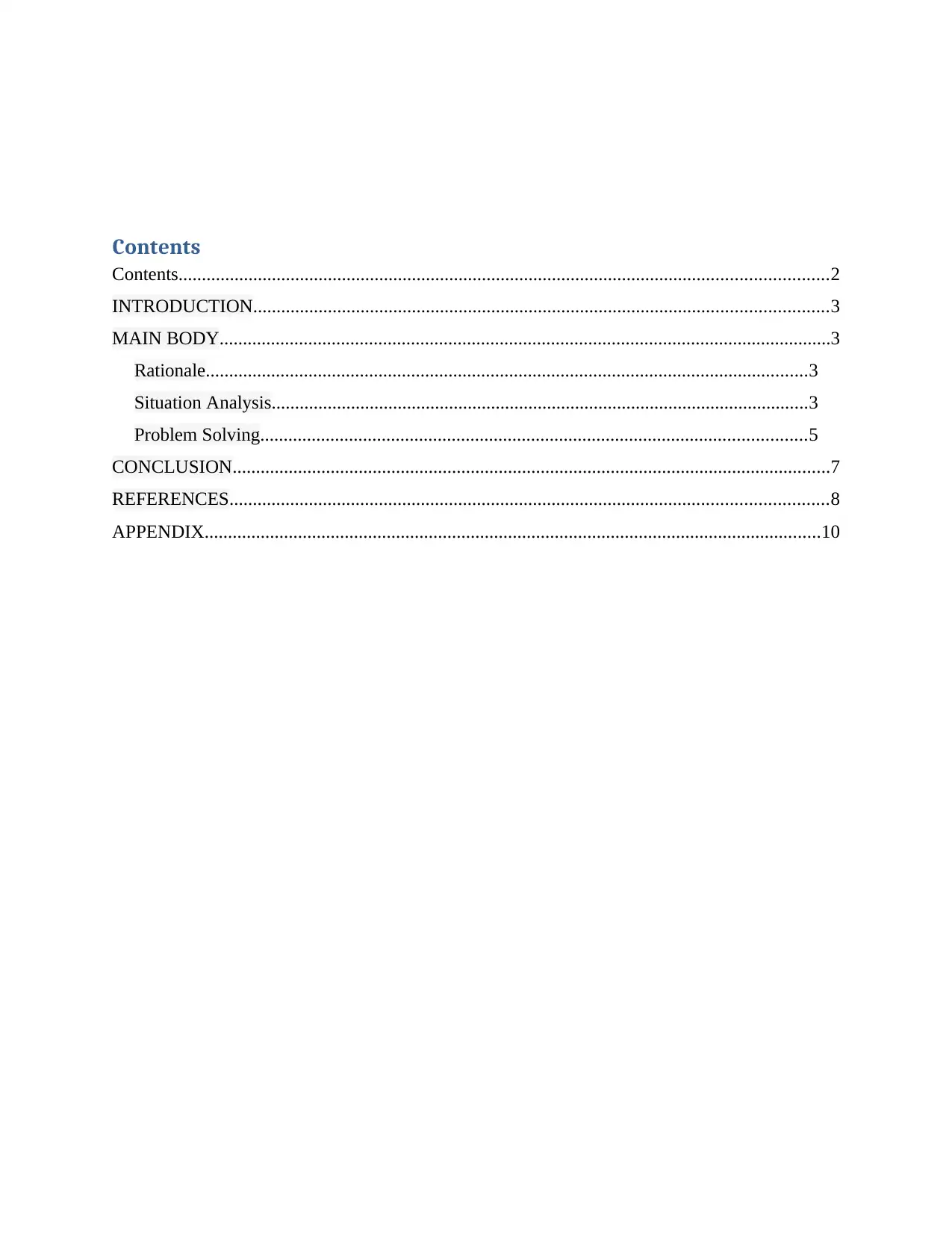
Contents
Contents...........................................................................................................................................2
INTRODUCTION...........................................................................................................................3
MAIN BODY...................................................................................................................................3
Rationale.................................................................................................................................3
Situation Analysis...................................................................................................................3
Problem Solving.....................................................................................................................5
CONCLUSION................................................................................................................................7
REFERENCES................................................................................................................................8
APPENDIX....................................................................................................................................10
Contents...........................................................................................................................................2
INTRODUCTION...........................................................................................................................3
MAIN BODY...................................................................................................................................3
Rationale.................................................................................................................................3
Situation Analysis...................................................................................................................3
Problem Solving.....................................................................................................................5
CONCLUSION................................................................................................................................7
REFERENCES................................................................................................................................8
APPENDIX....................................................................................................................................10
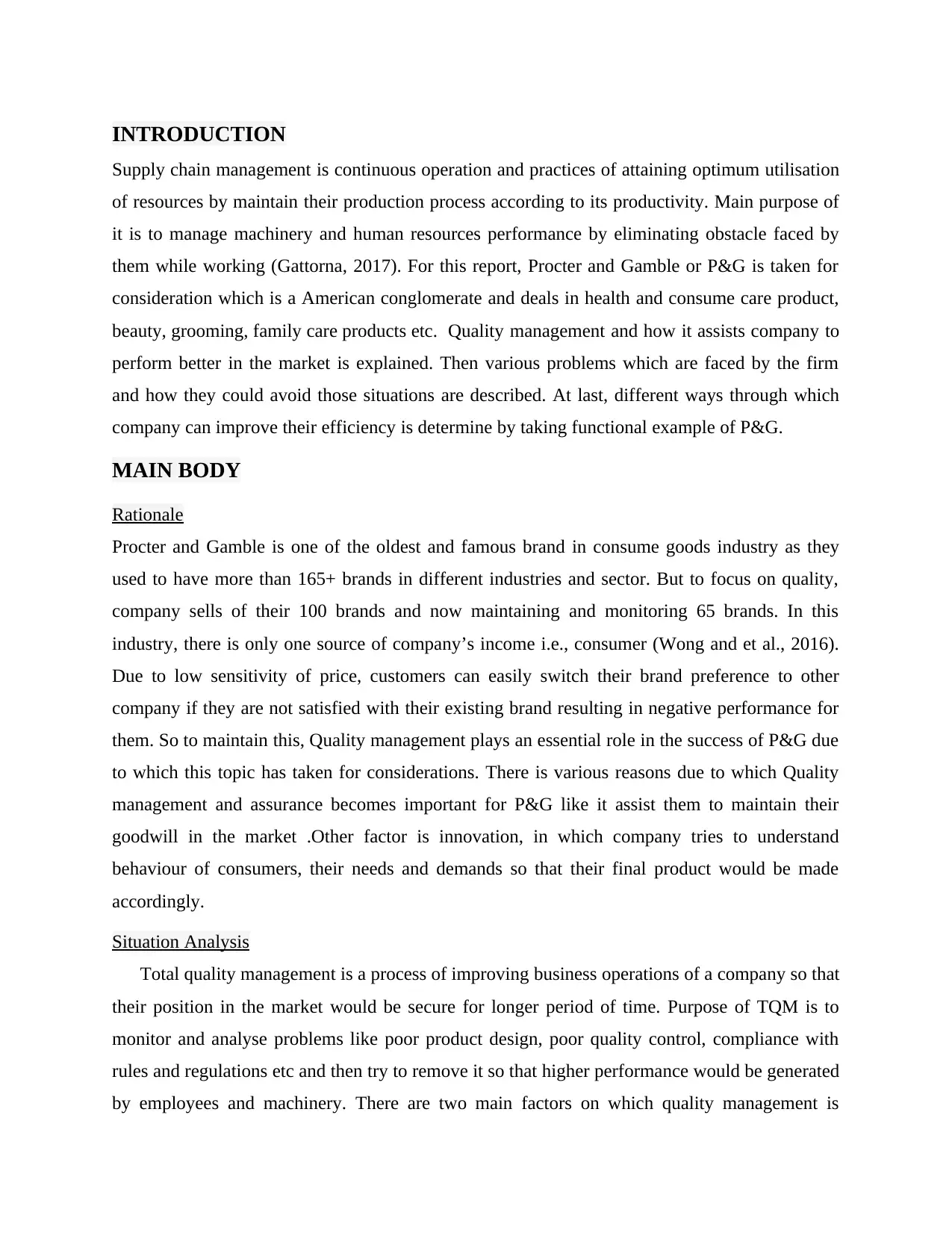
INTRODUCTION
Supply chain management is continuous operation and practices of attaining optimum utilisation
of resources by maintain their production process according to its productivity. Main purpose of
it is to manage machinery and human resources performance by eliminating obstacle faced by
them while working (Gattorna, 2017). For this report, Procter and Gamble or P&G is taken for
consideration which is a American conglomerate and deals in health and consume care product,
beauty, grooming, family care products etc. Quality management and how it assists company to
perform better in the market is explained. Then various problems which are faced by the firm
and how they could avoid those situations are described. At last, different ways through which
company can improve their efficiency is determine by taking functional example of P&G.
MAIN BODY
Rationale
Procter and Gamble is one of the oldest and famous brand in consume goods industry as they
used to have more than 165+ brands in different industries and sector. But to focus on quality,
company sells of their 100 brands and now maintaining and monitoring 65 brands. In this
industry, there is only one source of company’s income i.e., consumer (Wong and et al., 2016).
Due to low sensitivity of price, customers can easily switch their brand preference to other
company if they are not satisfied with their existing brand resulting in negative performance for
them. So to maintain this, Quality management plays an essential role in the success of P&G due
to which this topic has taken for considerations. There is various reasons due to which Quality
management and assurance becomes important for P&G like it assist them to maintain their
goodwill in the market .Other factor is innovation, in which company tries to understand
behaviour of consumers, their needs and demands so that their final product would be made
accordingly.
Situation Analysis
Total quality management is a process of improving business operations of a company so that
their position in the market would be secure for longer period of time. Purpose of TQM is to
monitor and analyse problems like poor product design, poor quality control, compliance with
rules and regulations etc and then try to remove it so that higher performance would be generated
by employees and machinery. There are two main factors on which quality management is
Supply chain management is continuous operation and practices of attaining optimum utilisation
of resources by maintain their production process according to its productivity. Main purpose of
it is to manage machinery and human resources performance by eliminating obstacle faced by
them while working (Gattorna, 2017). For this report, Procter and Gamble or P&G is taken for
consideration which is a American conglomerate and deals in health and consume care product,
beauty, grooming, family care products etc. Quality management and how it assists company to
perform better in the market is explained. Then various problems which are faced by the firm
and how they could avoid those situations are described. At last, different ways through which
company can improve their efficiency is determine by taking functional example of P&G.
MAIN BODY
Rationale
Procter and Gamble is one of the oldest and famous brand in consume goods industry as they
used to have more than 165+ brands in different industries and sector. But to focus on quality,
company sells of their 100 brands and now maintaining and monitoring 65 brands. In this
industry, there is only one source of company’s income i.e., consumer (Wong and et al., 2016).
Due to low sensitivity of price, customers can easily switch their brand preference to other
company if they are not satisfied with their existing brand resulting in negative performance for
them. So to maintain this, Quality management plays an essential role in the success of P&G due
to which this topic has taken for considerations. There is various reasons due to which Quality
management and assurance becomes important for P&G like it assist them to maintain their
goodwill in the market .Other factor is innovation, in which company tries to understand
behaviour of consumers, their needs and demands so that their final product would be made
accordingly.
Situation Analysis
Total quality management is a process of improving business operations of a company so that
their position in the market would be secure for longer period of time. Purpose of TQM is to
monitor and analyse problems like poor product design, poor quality control, compliance with
rules and regulations etc and then try to remove it so that higher performance would be generated
by employees and machinery. There are two main factors on which quality management is
⊘ This is a preview!⊘
Do you want full access?
Subscribe today to unlock all pages.

Trusted by 1+ million students worldwide
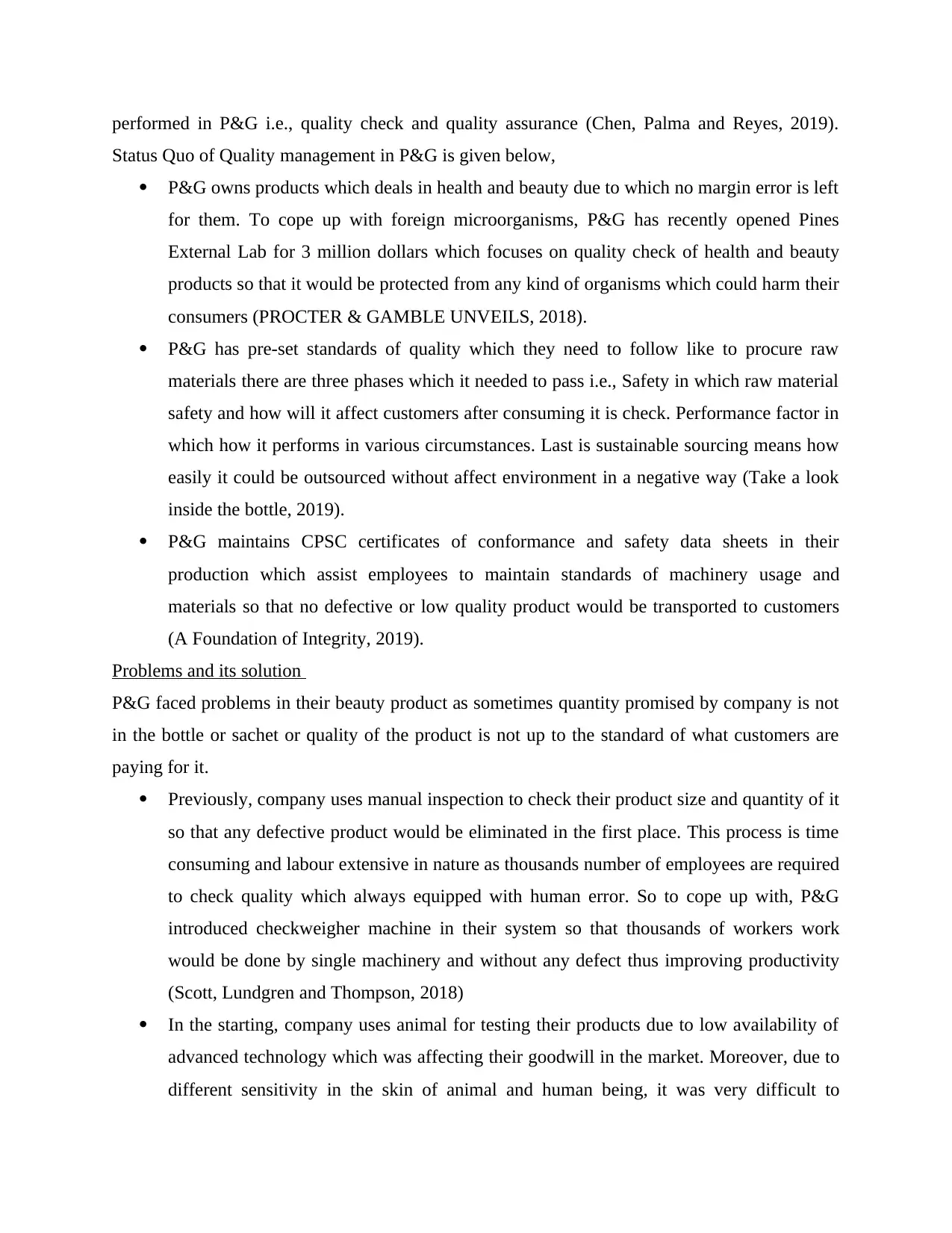
performed in P&G i.e., quality check and quality assurance (Chen, Palma and Reyes, 2019).
Status Quo of Quality management in P&G is given below,
P&G owns products which deals in health and beauty due to which no margin error is left
for them. To cope up with foreign microorganisms, P&G has recently opened Pines
External Lab for 3 million dollars which focuses on quality check of health and beauty
products so that it would be protected from any kind of organisms which could harm their
consumers (PROCTER & GAMBLE UNVEILS, 2018).
P&G has pre-set standards of quality which they need to follow like to procure raw
materials there are three phases which it needed to pass i.e., Safety in which raw material
safety and how will it affect customers after consuming it is check. Performance factor in
which how it performs in various circumstances. Last is sustainable sourcing means how
easily it could be outsourced without affect environment in a negative way (Take a look
inside the bottle, 2019).
P&G maintains CPSC certificates of conformance and safety data sheets in their
production which assist employees to maintain standards of machinery usage and
materials so that no defective or low quality product would be transported to customers
(A Foundation of Integrity, 2019).
Problems and its solution
P&G faced problems in their beauty product as sometimes quantity promised by company is not
in the bottle or sachet or quality of the product is not up to the standard of what customers are
paying for it.
Previously, company uses manual inspection to check their product size and quantity of it
so that any defective product would be eliminated in the first place. This process is time
consuming and labour extensive in nature as thousands number of employees are required
to check quality which always equipped with human error. So to cope up with, P&G
introduced checkweigher machine in their system so that thousands of workers work
would be done by single machinery and without any defect thus improving productivity
(Scott, Lundgren and Thompson, 2018)
In the starting, company uses animal for testing their products due to low availability of
advanced technology which was affecting their goodwill in the market. Moreover, due to
different sensitivity in the skin of animal and human being, it was very difficult to
Status Quo of Quality management in P&G is given below,
P&G owns products which deals in health and beauty due to which no margin error is left
for them. To cope up with foreign microorganisms, P&G has recently opened Pines
External Lab for 3 million dollars which focuses on quality check of health and beauty
products so that it would be protected from any kind of organisms which could harm their
consumers (PROCTER & GAMBLE UNVEILS, 2018).
P&G has pre-set standards of quality which they need to follow like to procure raw
materials there are three phases which it needed to pass i.e., Safety in which raw material
safety and how will it affect customers after consuming it is check. Performance factor in
which how it performs in various circumstances. Last is sustainable sourcing means how
easily it could be outsourced without affect environment in a negative way (Take a look
inside the bottle, 2019).
P&G maintains CPSC certificates of conformance and safety data sheets in their
production which assist employees to maintain standards of machinery usage and
materials so that no defective or low quality product would be transported to customers
(A Foundation of Integrity, 2019).
Problems and its solution
P&G faced problems in their beauty product as sometimes quantity promised by company is not
in the bottle or sachet or quality of the product is not up to the standard of what customers are
paying for it.
Previously, company uses manual inspection to check their product size and quantity of it
so that any defective product would be eliminated in the first place. This process is time
consuming and labour extensive in nature as thousands number of employees are required
to check quality which always equipped with human error. So to cope up with, P&G
introduced checkweigher machine in their system so that thousands of workers work
would be done by single machinery and without any defect thus improving productivity
(Scott, Lundgren and Thompson, 2018)
In the starting, company uses animal for testing their products due to low availability of
advanced technology which was affecting their goodwill in the market. Moreover, due to
different sensitivity in the skin of animal and human being, it was very difficult to
Paraphrase This Document
Need a fresh take? Get an instant paraphrase of this document with our AI Paraphraser
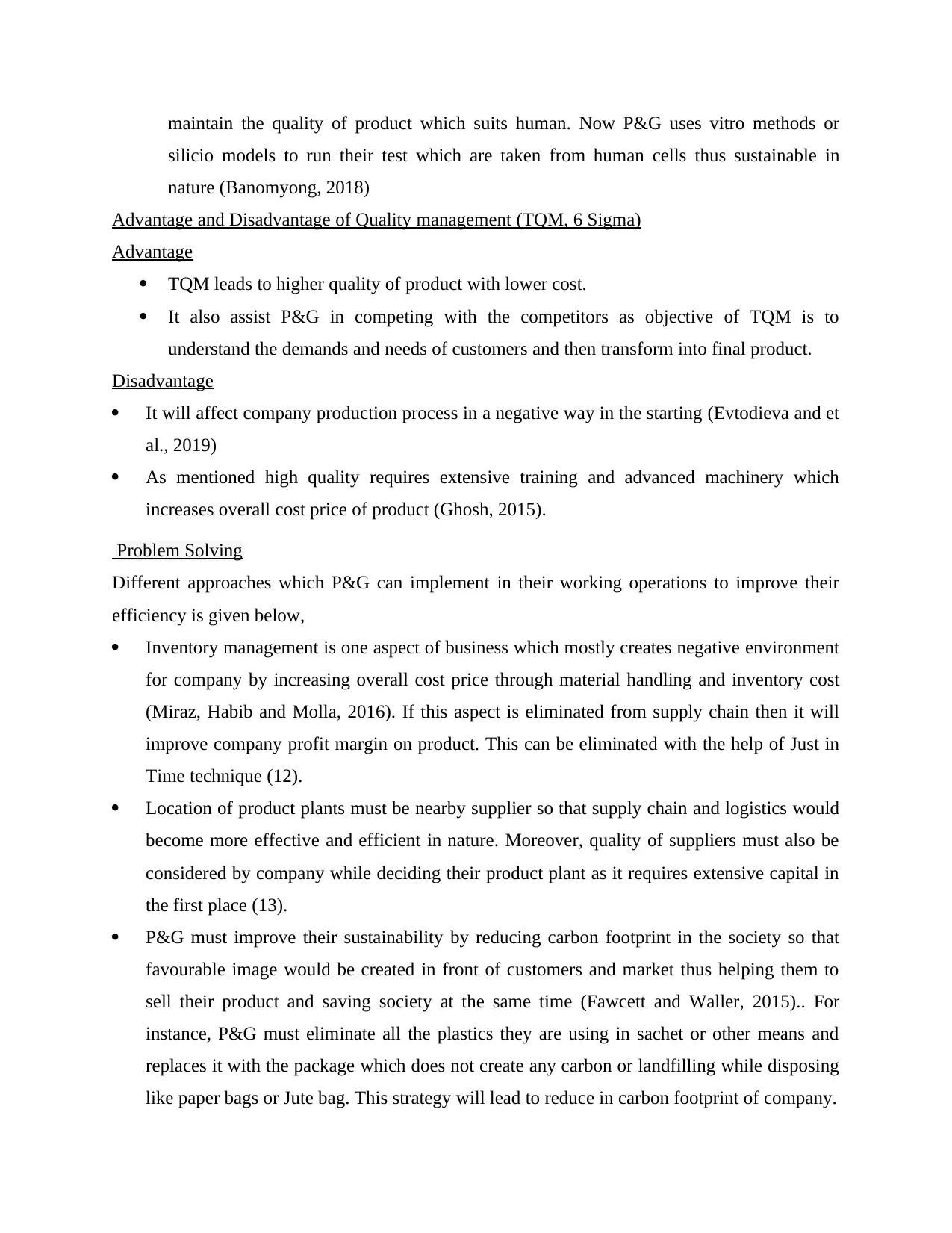
maintain the quality of product which suits human. Now P&G uses vitro methods or
silicio models to run their test which are taken from human cells thus sustainable in
nature (Banomyong, 2018)
Advantage and Disadvantage of Quality management (TQM, 6 Sigma)
Advantage
TQM leads to higher quality of product with lower cost.
It also assist P&G in competing with the competitors as objective of TQM is to
understand the demands and needs of customers and then transform into final product.
Disadvantage
It will affect company production process in a negative way in the starting (Evtodieva and et
al., 2019)
As mentioned high quality requires extensive training and advanced machinery which
increases overall cost price of product (Ghosh, 2015).
Problem Solving
Different approaches which P&G can implement in their working operations to improve their
efficiency is given below,
Inventory management is one aspect of business which mostly creates negative environment
for company by increasing overall cost price through material handling and inventory cost
(Miraz, Habib and Molla, 2016). If this aspect is eliminated from supply chain then it will
improve company profit margin on product. This can be eliminated with the help of Just in
Time technique (12).
Location of product plants must be nearby supplier so that supply chain and logistics would
become more effective and efficient in nature. Moreover, quality of suppliers must also be
considered by company while deciding their product plant as it requires extensive capital in
the first place (13).
P&G must improve their sustainability by reducing carbon footprint in the society so that
favourable image would be created in front of customers and market thus helping them to
sell their product and saving society at the same time (Fawcett and Waller, 2015).. For
instance, P&G must eliminate all the plastics they are using in sachet or other means and
replaces it with the package which does not create any carbon or landfilling while disposing
like paper bags or Jute bag. This strategy will lead to reduce in carbon footprint of company.
silicio models to run their test which are taken from human cells thus sustainable in
nature (Banomyong, 2018)
Advantage and Disadvantage of Quality management (TQM, 6 Sigma)
Advantage
TQM leads to higher quality of product with lower cost.
It also assist P&G in competing with the competitors as objective of TQM is to
understand the demands and needs of customers and then transform into final product.
Disadvantage
It will affect company production process in a negative way in the starting (Evtodieva and et
al., 2019)
As mentioned high quality requires extensive training and advanced machinery which
increases overall cost price of product (Ghosh, 2015).
Problem Solving
Different approaches which P&G can implement in their working operations to improve their
efficiency is given below,
Inventory management is one aspect of business which mostly creates negative environment
for company by increasing overall cost price through material handling and inventory cost
(Miraz, Habib and Molla, 2016). If this aspect is eliminated from supply chain then it will
improve company profit margin on product. This can be eliminated with the help of Just in
Time technique (12).
Location of product plants must be nearby supplier so that supply chain and logistics would
become more effective and efficient in nature. Moreover, quality of suppliers must also be
considered by company while deciding their product plant as it requires extensive capital in
the first place (13).
P&G must improve their sustainability by reducing carbon footprint in the society so that
favourable image would be created in front of customers and market thus helping them to
sell their product and saving society at the same time (Fawcett and Waller, 2015).. For
instance, P&G must eliminate all the plastics they are using in sachet or other means and
replaces it with the package which does not create any carbon or landfilling while disposing
like paper bags or Jute bag. This strategy will lead to reduce in carbon footprint of company.
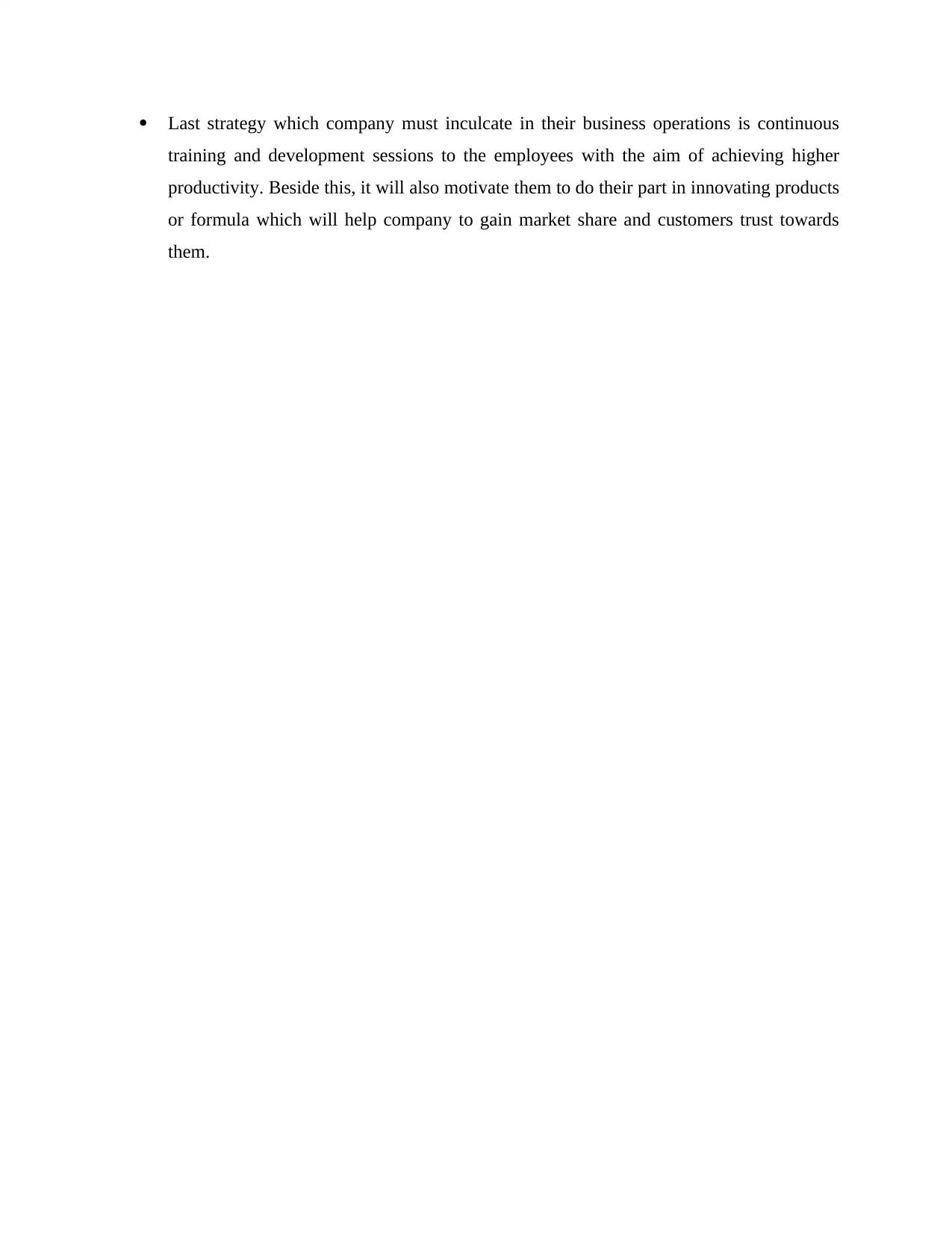
Last strategy which company must inculcate in their business operations is continuous
training and development sessions to the employees with the aim of achieving higher
productivity. Beside this, it will also motivate them to do their part in innovating products
or formula which will help company to gain market share and customers trust towards
them.
training and development sessions to the employees with the aim of achieving higher
productivity. Beside this, it will also motivate them to do their part in innovating products
or formula which will help company to gain market share and customers trust towards
them.
⊘ This is a preview!⊘
Do you want full access?
Subscribe today to unlock all pages.

Trusted by 1+ million students worldwide
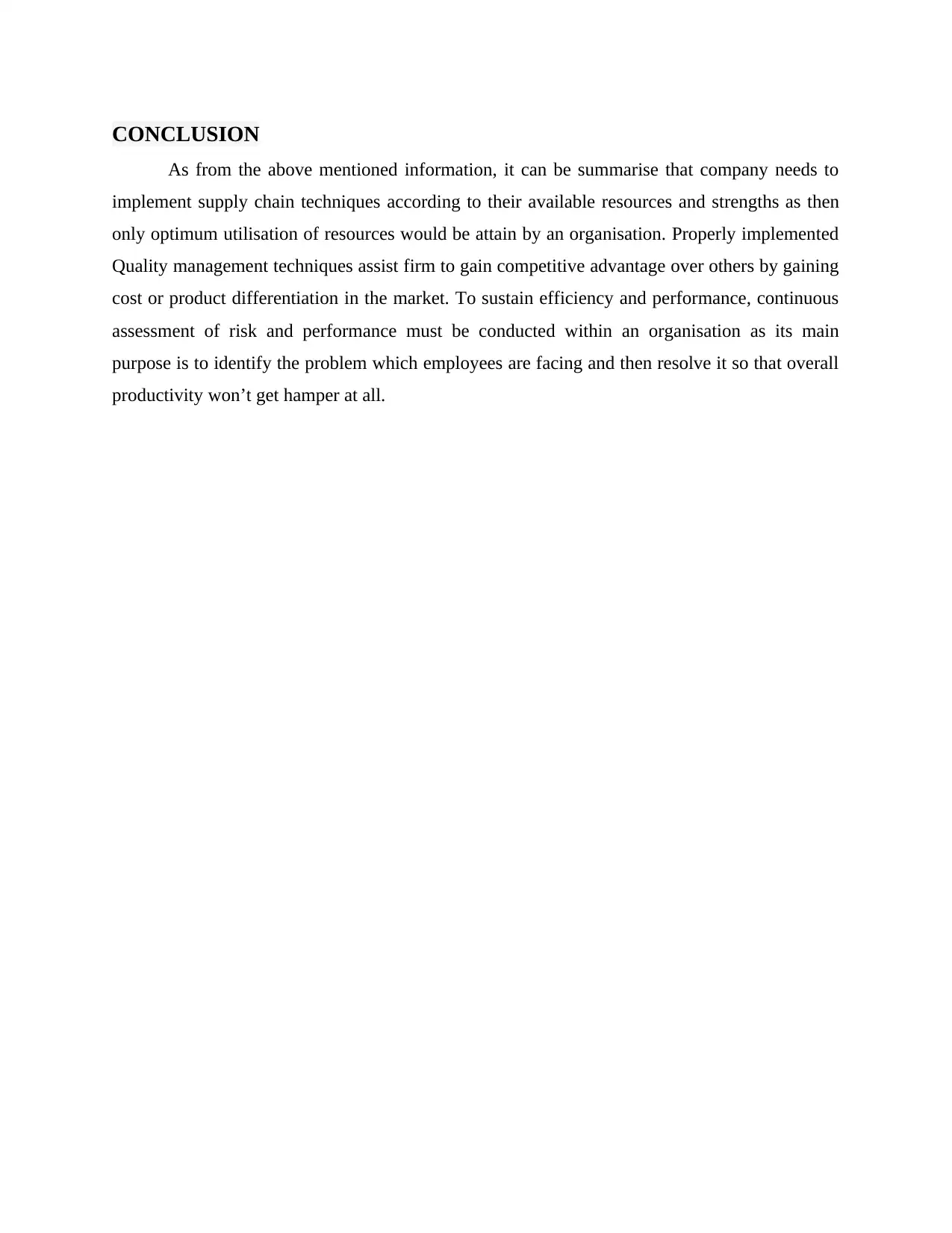
CONCLUSION
As from the above mentioned information, it can be summarise that company needs to
implement supply chain techniques according to their available resources and strengths as then
only optimum utilisation of resources would be attain by an organisation. Properly implemented
Quality management techniques assist firm to gain competitive advantage over others by gaining
cost or product differentiation in the market. To sustain efficiency and performance, continuous
assessment of risk and performance must be conducted within an organisation as its main
purpose is to identify the problem which employees are facing and then resolve it so that overall
productivity won’t get hamper at all.
As from the above mentioned information, it can be summarise that company needs to
implement supply chain techniques according to their available resources and strengths as then
only optimum utilisation of resources would be attain by an organisation. Properly implemented
Quality management techniques assist firm to gain competitive advantage over others by gaining
cost or product differentiation in the market. To sustain efficiency and performance, continuous
assessment of risk and performance must be conducted within an organisation as its main
purpose is to identify the problem which employees are facing and then resolve it so that overall
productivity won’t get hamper at all.
Paraphrase This Document
Need a fresh take? Get an instant paraphrase of this document with our AI Paraphraser
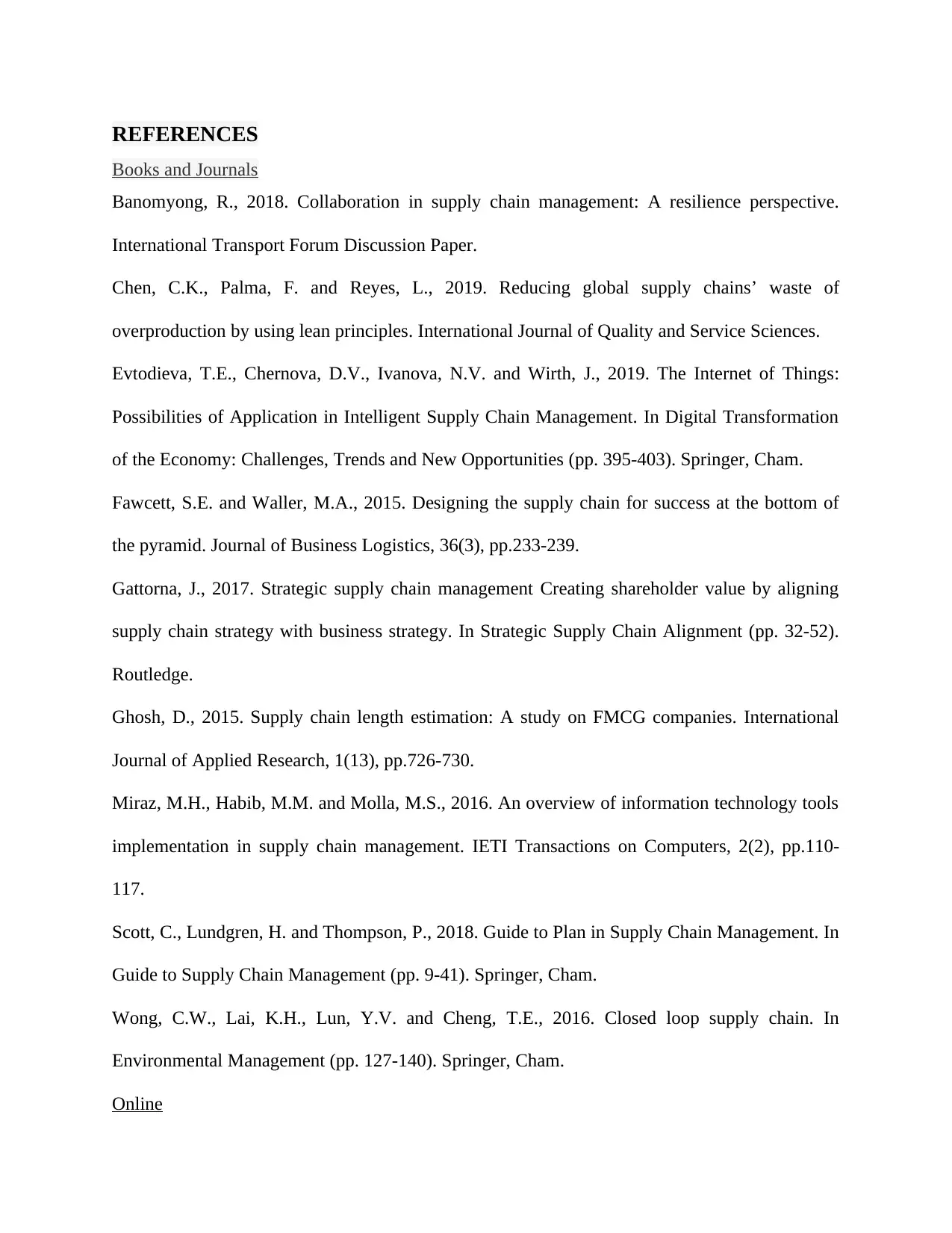
REFERENCES
Books and Journals
Banomyong, R., 2018. Collaboration in supply chain management: A resilience perspective.
International Transport Forum Discussion Paper.
Chen, C.K., Palma, F. and Reyes, L., 2019. Reducing global supply chains’ waste of
overproduction by using lean principles. International Journal of Quality and Service Sciences.
Evtodieva, T.E., Chernovа, D.V., Ivanova, N.V. and Wirth, J., 2019. The Internet of Things:
Possibilities of Application in Intelligent Supply Chain Management. In Digital Transformation
of the Economy: Challenges, Trends and New Opportunities (pp. 395-403). Springer, Cham.
Fawcett, S.E. and Waller, M.A., 2015. Designing the supply chain for success at the bottom of
the pyramid. Journal of Business Logistics, 36(3), pp.233-239.
Gattorna, J., 2017. Strategic supply chain management Creating shareholder value by aligning
supply chain strategy with business strategy. In Strategic Supply Chain Alignment (pp. 32-52).
Routledge.
Ghosh, D., 2015. Supply chain length estimation: A study on FMCG companies. International
Journal of Applied Research, 1(13), pp.726-730.
Miraz, M.H., Habib, M.M. and Molla, M.S., 2016. An overview of information technology tools
implementation in supply chain management. IETI Transactions on Computers, 2(2), pp.110-
117.
Scott, C., Lundgren, H. and Thompson, P., 2018. Guide to Plan in Supply Chain Management. In
Guide to Supply Chain Management (pp. 9-41). Springer, Cham.
Wong, C.W., Lai, K.H., Lun, Y.V. and Cheng, T.E., 2016. Closed loop supply chain. In
Environmental Management (pp. 127-140). Springer, Cham.
Online
Books and Journals
Banomyong, R., 2018. Collaboration in supply chain management: A resilience perspective.
International Transport Forum Discussion Paper.
Chen, C.K., Palma, F. and Reyes, L., 2019. Reducing global supply chains’ waste of
overproduction by using lean principles. International Journal of Quality and Service Sciences.
Evtodieva, T.E., Chernovа, D.V., Ivanova, N.V. and Wirth, J., 2019. The Internet of Things:
Possibilities of Application in Intelligent Supply Chain Management. In Digital Transformation
of the Economy: Challenges, Trends and New Opportunities (pp. 395-403). Springer, Cham.
Fawcett, S.E. and Waller, M.A., 2015. Designing the supply chain for success at the bottom of
the pyramid. Journal of Business Logistics, 36(3), pp.233-239.
Gattorna, J., 2017. Strategic supply chain management Creating shareholder value by aligning
supply chain strategy with business strategy. In Strategic Supply Chain Alignment (pp. 32-52).
Routledge.
Ghosh, D., 2015. Supply chain length estimation: A study on FMCG companies. International
Journal of Applied Research, 1(13), pp.726-730.
Miraz, M.H., Habib, M.M. and Molla, M.S., 2016. An overview of information technology tools
implementation in supply chain management. IETI Transactions on Computers, 2(2), pp.110-
117.
Scott, C., Lundgren, H. and Thompson, P., 2018. Guide to Plan in Supply Chain Management. In
Guide to Supply Chain Management (pp. 9-41). Springer, Cham.
Wong, C.W., Lai, K.H., Lun, Y.V. and Cheng, T.E., 2016. Closed loop supply chain. In
Environmental Management (pp. 127-140). Springer, Cham.
Online
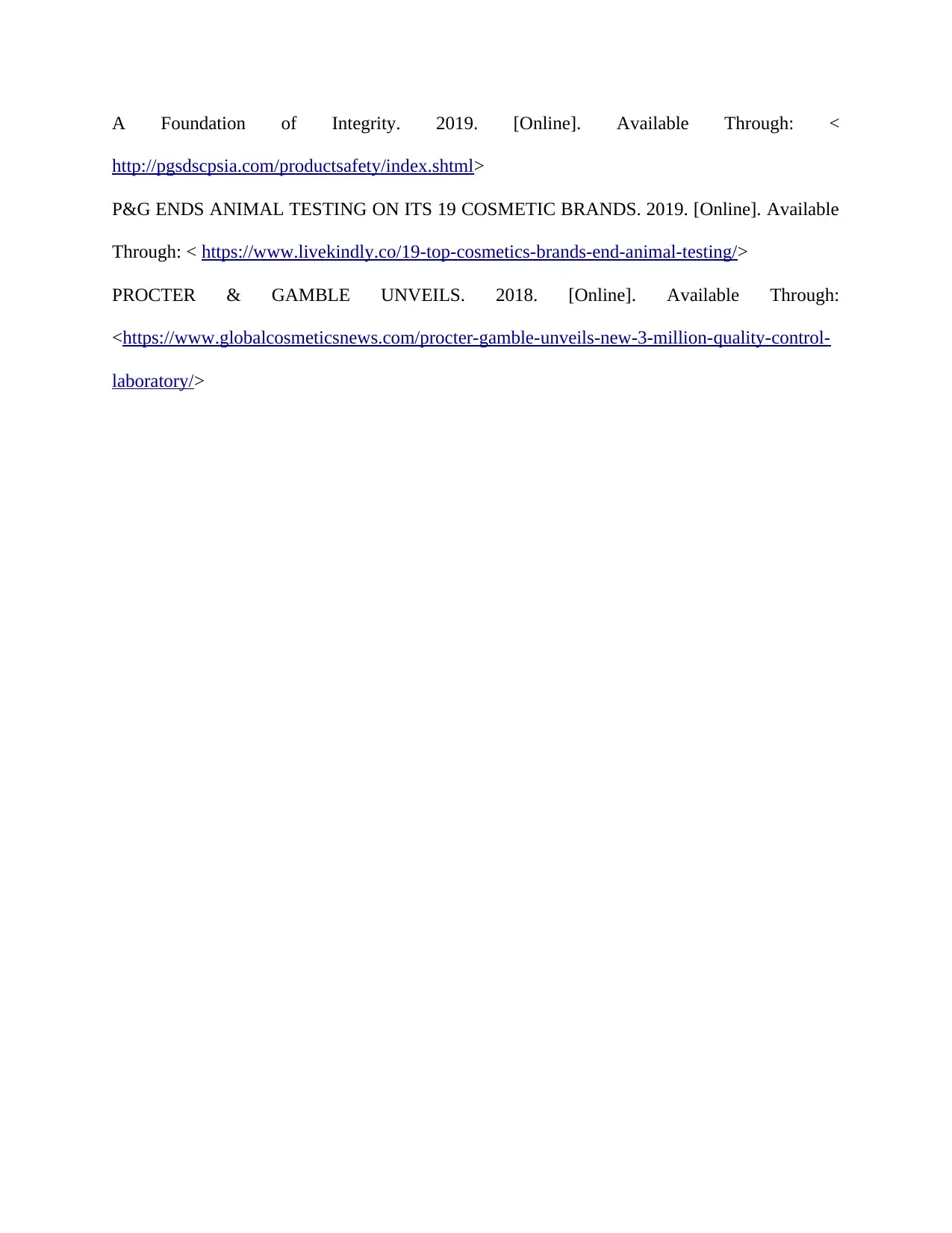
A Foundation of Integrity. 2019. [Online]. Available Through: <
http://pgsdscpsia.com/productsafety/index.shtml>
P&G ENDS ANIMAL TESTING ON ITS 19 COSMETIC BRANDS. 2019. [Online]. Available
Through: < https://www.livekindly.co/19-top-cosmetics-brands-end-animal-testing/>
PROCTER & GAMBLE UNVEILS. 2018. [Online]. Available Through:
<https://www.globalcosmeticsnews.com/procter-gamble-unveils-new-3-million-quality-control-
laboratory/>
http://pgsdscpsia.com/productsafety/index.shtml>
P&G ENDS ANIMAL TESTING ON ITS 19 COSMETIC BRANDS. 2019. [Online]. Available
Through: < https://www.livekindly.co/19-top-cosmetics-brands-end-animal-testing/>
PROCTER & GAMBLE UNVEILS. 2018. [Online]. Available Through:
<https://www.globalcosmeticsnews.com/procter-gamble-unveils-new-3-million-quality-control-
laboratory/>
⊘ This is a preview!⊘
Do you want full access?
Subscribe today to unlock all pages.

Trusted by 1+ million students worldwide
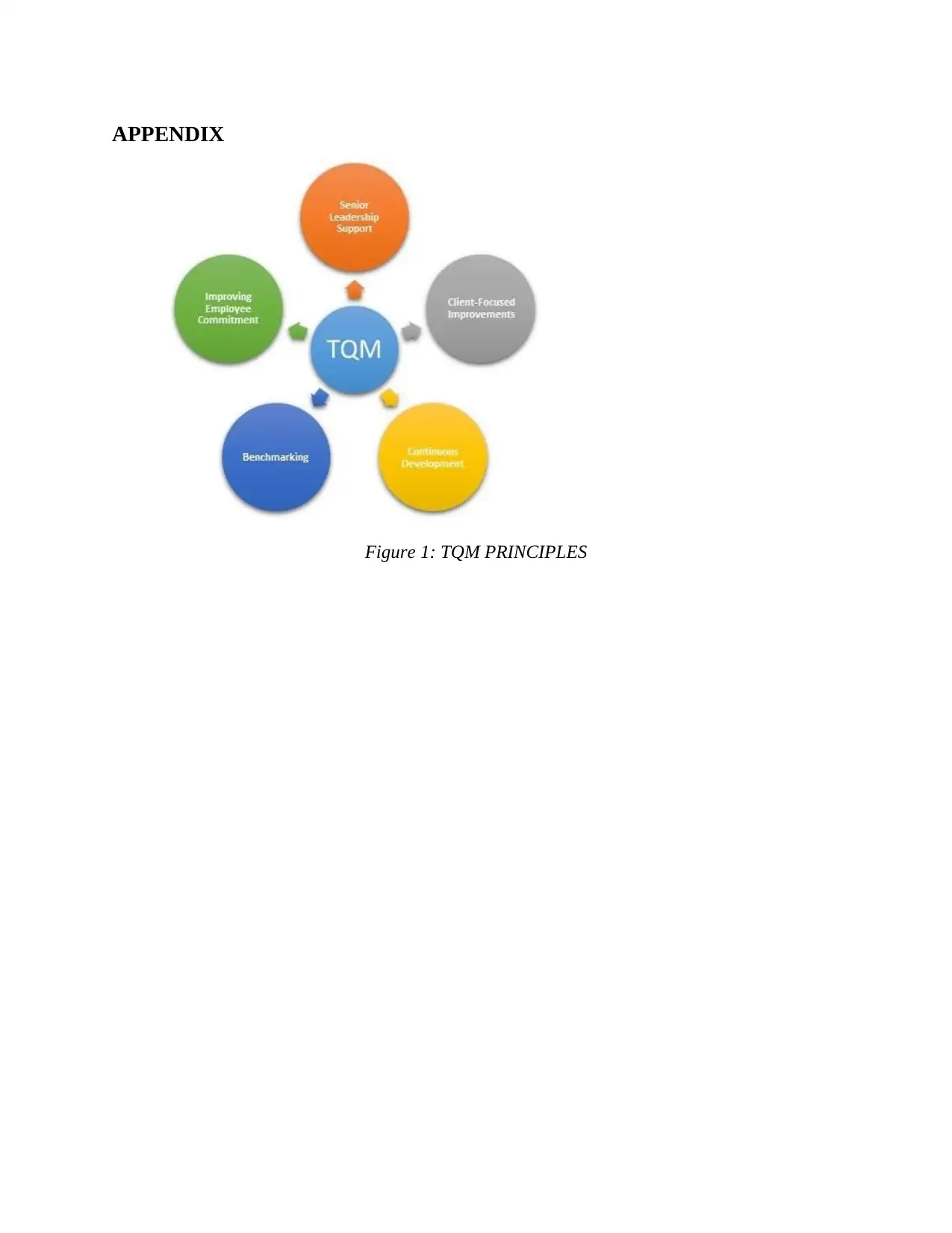
APPENDIX
Figure 1: TQM PRINCIPLES
Figure 1: TQM PRINCIPLES
Paraphrase This Document
Need a fresh take? Get an instant paraphrase of this document with our AI Paraphraser
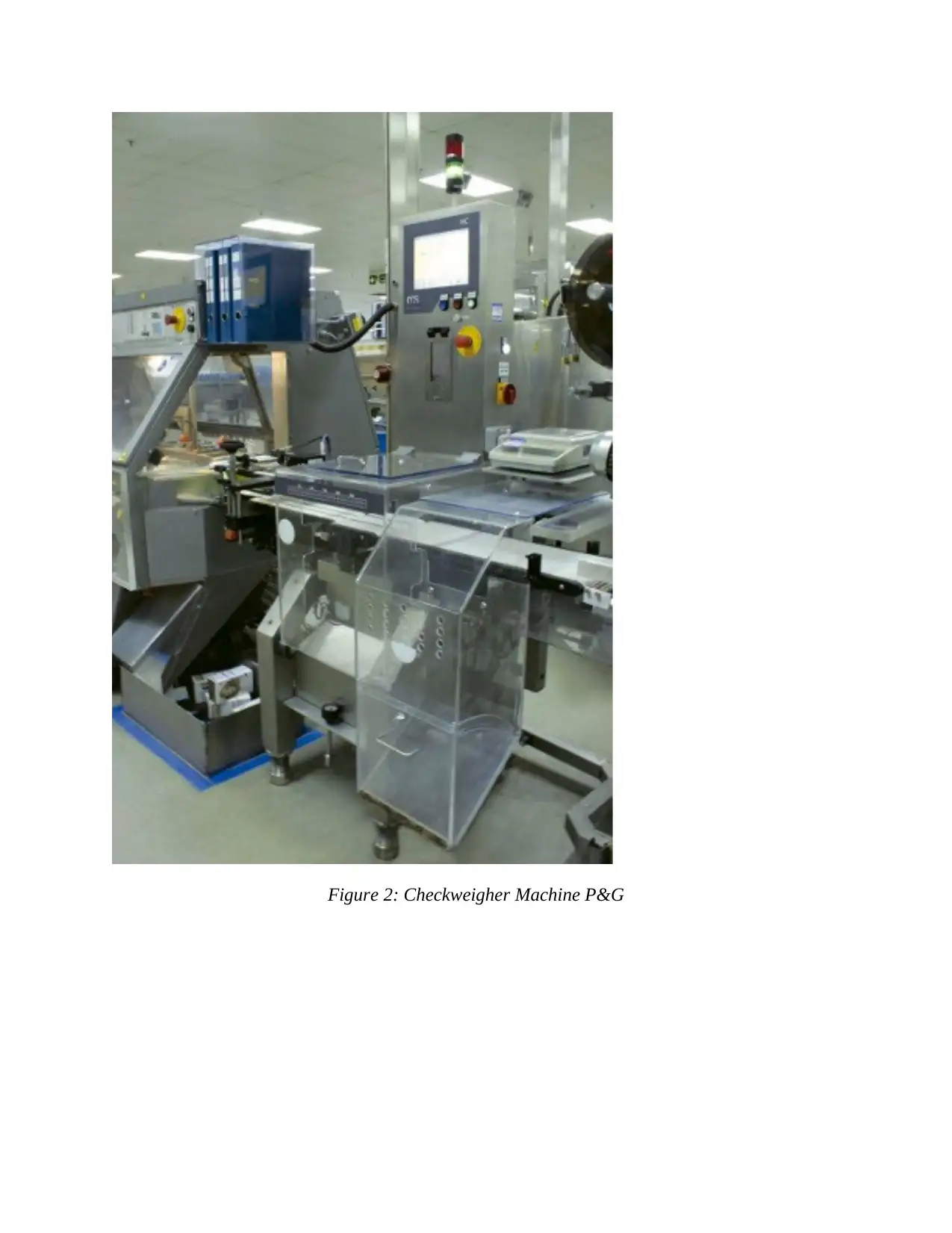
Figure 2: Checkweigher Machine P&G
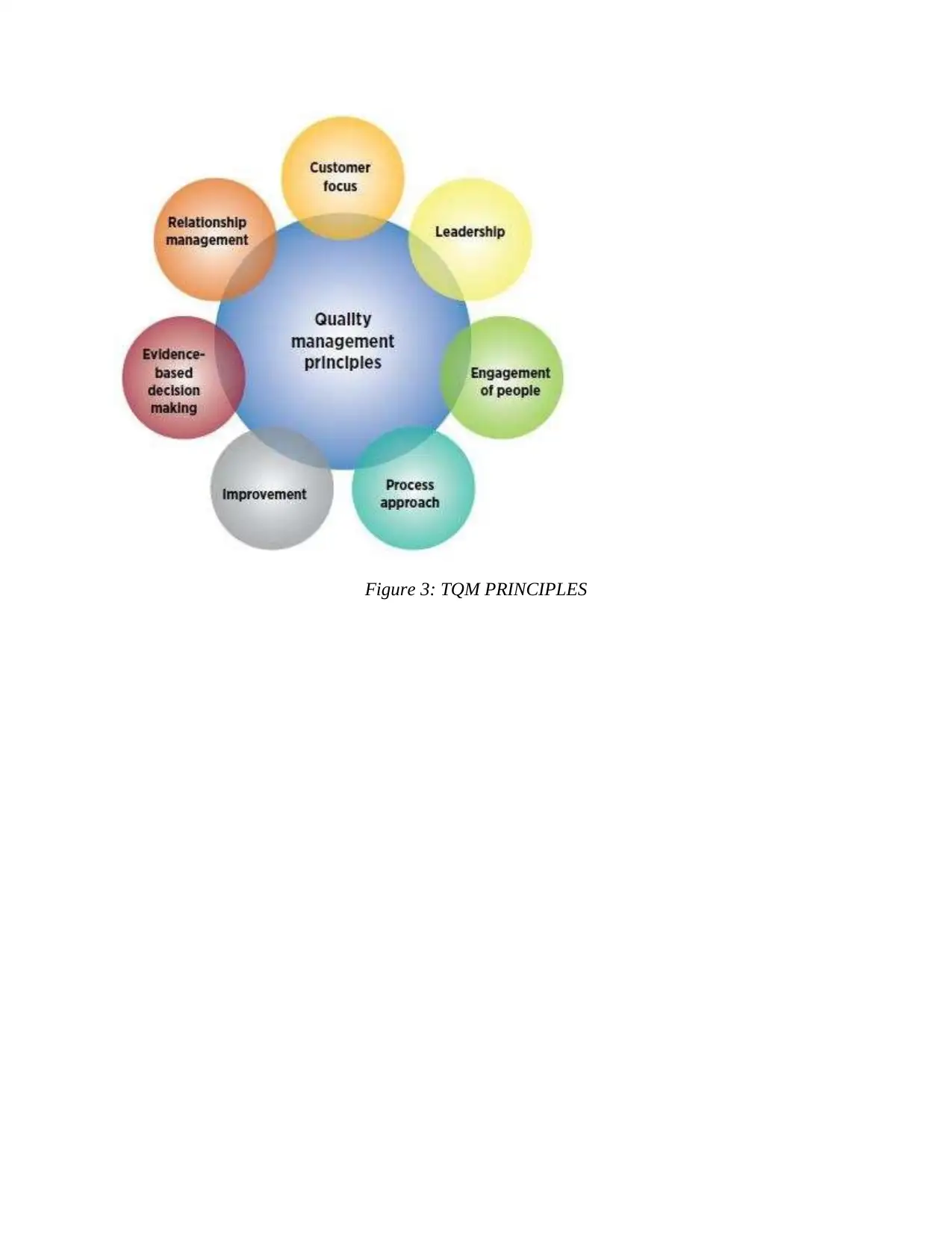
Figure 3: TQM PRINCIPLES
⊘ This is a preview!⊘
Do you want full access?
Subscribe today to unlock all pages.

Trusted by 1+ million students worldwide
1 out of 12
Related Documents
Your All-in-One AI-Powered Toolkit for Academic Success.
+13062052269
info@desklib.com
Available 24*7 on WhatsApp / Email
![[object Object]](/_next/static/media/star-bottom.7253800d.svg)
Unlock your academic potential
Copyright © 2020–2025 A2Z Services. All Rights Reserved. Developed and managed by ZUCOL.




